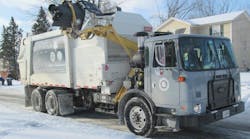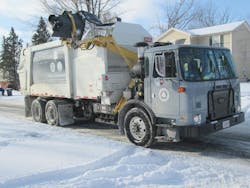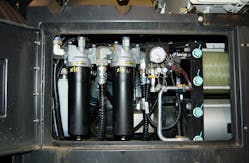Shortly after midnight on February 15, 2014, firefighters in Oberlin, Ohio responded to a fire at the city’s refuse vehicle garage. The building housed the city’s fleet of six garbage and recycling trucks. All of them were destroyed. Scott Broadwell, President of Oberlin’s City Council, said it was fortunate that no one was injured in the incident, and leadership for the city of Oberlin acted quickly by renting two trucks to begin waste collection the following Tuesday. Jeff Baumann, Publics Works Director for the city, explained, “We normally don’t collect residential waste on Mondays, but because we were able to have trucks on the streets by Tuesday, residents saw no interruption in service.” Both agreed that the fire breaking out in the middle of the night helped prevent injuries because people were not in the service garage at the time.
But renting trucks was a temporary solution, so when officials met to devise a permanent solution, leadership recommitted to its zero-waste policy. As a result, they decided to replace the fleet with hydraulic hybrid trucks. The action came from joint efforts between the city of Oberlin, Oberlin College, and the Ohio Environmental Protection Agency to obtain three new collection trucks using the RunWise hydraulic hybrid drive system from Parker Hannifin Corp. As part of this commitment, Oberlin received a grant of $200,000 from the Ohio Environmental Protection Agency to replace the fleet with the hydraulic hybrid trucks. Funds were also proved by the Green Edge Fund at Oberlin College.
Hydraulic hybrid operation
The RunWise system in the Oberlin trucks uses three Parker C24 pump/motors. The C24 is a bent-axis piston pump/motor featuring several proprietary design and construction characteristics for this application. One pump is driven by the truck’s engine for pressurizing the system. Each of the other two is connected to a rear wheel drive to capture braking energy to decelerate the truck and to accelerate the vehicle using the stored energy. Other key components of the system are accumulators that capture and release braking energy.
In essence, when the driver depresses the brake pedal, the two rear pump/motors act as pumps by transmitting the kinetic energy of the moving truck into hydraulic power. This energy conversion decelerates the truck, and the hydraulic energy is stored in the accumulators. When the driver then depresses the accelerator pedal, the hydraulic energy is released from the accumulators to drive the pump/motors, accelerating the truck.
Multiple modes of savings
Ben Mather, VP of Operations for Parker’s Hydraulics Group, said that without the RunWise System, each of Oberlin’s trucks would consume about 8,600 gal of fuel per year. The RunWise system is expected to cut fuel consumption roughly in half, saving Oberin more than 4,000 gal of fuel per year for each truck. Tom DeCoster, Business Development Manager for Parker’s Hydbrid Drive Div., added, “The RunWise system regenerates more than 70% of braking energy, so brakes last about eight times longer with RunWise. The downtime and cost of labor and parts for these trucks are substantial. A conventional refuse truck might need to have its brakes serviced two or three times a year, but, potentially, the brakes in these trucks could last the life of the vehicle.”
Another benefit of the RunWise system is lower emissions. Mather continued, “By using hydraulics to regenerate braking energy into vehicle acceleration, we reduce CO2 emissions from each truck that’s equal to taking nearly seven cars off the road. Furthermore, the vehicles run quieter. You won’t hear brakes squealing as these trucks make frequent stops, and you won’t hear the engines race to accelerate the vehicle to the next stop.”
What it’s made of
The hydraulic system itself has low- and high-pressure circuits. The engine-driven pump keeps the low-pressure circuit charged to 65 to 70 psi for maintaining positive inlet pressure to the two rear pump-motors driving the wheels. However, hydraulic fluid in sealed, pressurized systems tends to retain air. To circumvent this potential problem, the system has a de-aeration tank that allows air to disperse from the hydraulic fluid.
Refuse trucks are heavy, but even in these heavy-duty vehicles, more weight means higher fuel consumption. Therefore, the RunWise system is also designed to conserve weight. This is done, in part, by using accumulators with a high-strength, lightweight composite shell. Conventional steel accumulators of this size weigh hundreds of pounds. The composite accumulators weigh less than their steel counterparts; the result is a system that weighs less than if it used steel accumulators.
The vehicle drive consists of a transmission coupled to the engine. The transmission either provides power to the hydraulic pump or to a mechanical drive shaft connected to the rear wheels. An electronic drive control not only controls pressure and flow of the hybrid hydraulic system, but also selects the drive mode. When the truck is collecting waste, it travels from one property to another, then stops. This provides the maximum opportunity to regenerate braking energy, and the drive control operates the hydraulic system in its low-speed mode — for speeds up to about 25 mph.
When the vehicle will travel a short distance, say to another street or nearby neighborhood, the control shifts the hydraulic system into its high-speed mode —between about 25 and 45 mph. The transition is accomplished automatically and with no intervention from the driver. When the vehicle is done with a route and heads for the highway, the drive control automatically switches to direct-drive mode. This occurs when speed exceeds about 45 mph, and, again, with no driver intervention. So whether the vehicle is collecting waste with frequent stops from one home to another, travelling from one neighborhood to another, or heading for a landfill or recycling facility, the control always puts the drive in the most economical mode.
A bright future
DeCoster said the potential growth for hybrid drives led Parker to form its Hybrid Drive System Div., located in Columbus, Ohio, in 2011. He offered, “We now have 160 refuse trucks using our RunWise system in North America alone, plus another 48 that are used in delivery trucks.” And as with any new technology, its capabilities are expected to improve as more systems come into use.



